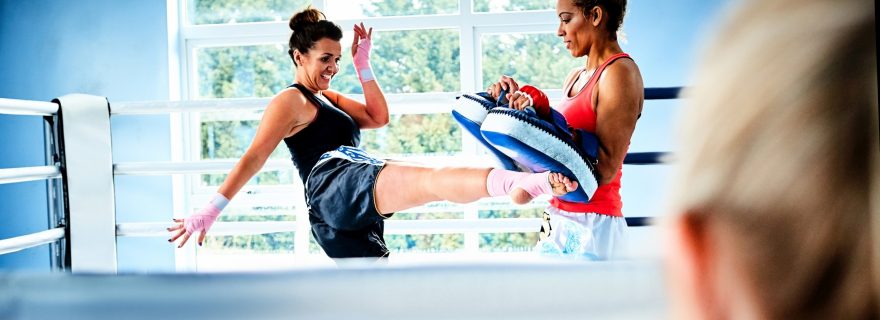Learning and Belonging in Ladies-Only Kickboxing
Kickboxing has been promoted to young Muslim and Moroccan-Dutch women as a tool for empowerment. How can we understand their participation in sports? How are their practices influenced by dominant discourses, policies, and media on the female Muslim body?
Muslim girls and young women are increasingly active in kickboxing in the Netherlands. While some join mixed-gender sessions, gender-segregated training sessions have lowered the threshold for many women and girls to engage in combat sports. In looking into women’s ‘fight clubs’ in the Netherlands, my PhD dissertation examines their motivations for kickboxing as well as the effects of participation on notions of self and senses of belonging in society. Why and how do young Muslim women engage in kickboxing? How do multiple existing forms of identification – gender, class, race/ethnicity and religion – affect their engagement?
My thesis argues that their motivations are not naturally given, but are affected by existing multiple forms of identification, while their access to resources is structured by their intersecting positions in multiple fields of power (including gender, class, race/ethnicity, and religion). At the same time, an inquiry of the process of enskilment – acquiring bodily knowledge and the acquisition of skills – demonstrates how notions of self and senses of belonging are (re)produced. I focus on the phenomenon of kickboxing in the lives of Muslim women and girls who attend ladies-only classes in two gyms in so-called disadvantaged neighbourhoods. Based on intensive fieldwork – in which I trained and participated in ladies-only kickboxing classes while interviewing the participants – the findings of this study privilege the participants’ voices and stories of how and why they engage in kickboxing, and what it means to them.
‘Saved’ by sports
For two decades now, kickboxing has been marketed as a tool to empower Muslim women and equip them with the physical skill and power to rescue, strengthen, and – as anthropologist Lila Abu-Lughod would say – ‘save’ them; at the same time, however, the general public is warned about its glorification of violence and alleged links with organized crime. I found that ladies-only kickboxing is embedded in ‘integration-through-sports’ policies. Sports create a vicious circle for Moroccan-Dutch and Muslim youth – a vicious circle in which race/ethnicity and gender power imbalances are reproduced.
Participation in sports, specifically for minority groups, is presented as a gateway to participation in society. Although some policy documents and programs emphasize participation in sports as a goal in and of itself, between the lines we can read that participation in sports is increasingly presented as a means to produce a disciplined Muslim and Moroccan-Dutch citizen.
The role of religion and gender in learning kickboxing
As learning kickboxing is not a linear process, becoming a kickboxer is different in each environment; gender-segregated kickboxing training is imbued with ideas of race/ethnicity, gender, age, and locality. Therefore, researching learning and ways of knowing not only provides insight into the practice of kickboxing and the notion of being a kickboxer, but into different ways of knowing as they relate to gender, race/ethnicity, class, and religion. The dichotomy of a powerless Muslim girl and a powerful sport is an important reason behind the assumption that kickboxing is a form of feminist agency for young Muslim women.
I argue that religiosities and femininities are (re)produced and performed of in the perceived secular and masculine space of the gym. It is tempting to think in ‘ways of being a female Muslim’, or a ‘Muslim female habitus’, but these categorizations don’t do justice to the complexities of the lives of the kickboxers. They participate in a form of exercise that is widely perceived as aggressive and that is offered to them as a way of ‘empowering’ youthful minority femininity –sd. This ‘empowers’ them in ways not foreseen by those who develop such programs. Young women and girls challenge the notion of a so-called ‘masculine’ sport by turning it into a source of casual comfort for themselves, at least within the walls of their gym during their ladies-only sessions.
Subtleties in everyday life
My research pays attention to the subtleties of the doubly contested ladies-only kickboxing. On the one hand, this sport is perceived as an emancipatory, liberal practice, precisely because of the racial and religious backgrounds of the women and girls. On the other hand, the effects of gender-segregated sports settings still reinforce heteronormative gender identifications.
Although this thesis demonstrates that the gender binary is indeed upheld within this recreational kickboxing training, it challenges the male-dominated space of kickboxing at large. Both in the Dutch context and worldwide, ethnic femininity is constructed as antagonistic to physical activity in general. Young Dutch Muslim women and girls who take up kickboxing confront important aspects of representations of the intersection of gender and ethnicity. While there might be a desire to ‘save’ young Muslim women and girls through participation in sports, the participants determine for themselves what form their participation will take and what role it will play in their lives.
Jasmijn Rana defended her dissertation ‘Learning and Belonging: An Ethnography of Dutch Muslim Women in Kickboxing’ on 10 July 2017 at the Freie Universität Berlin.



0 Comments
Add a comment